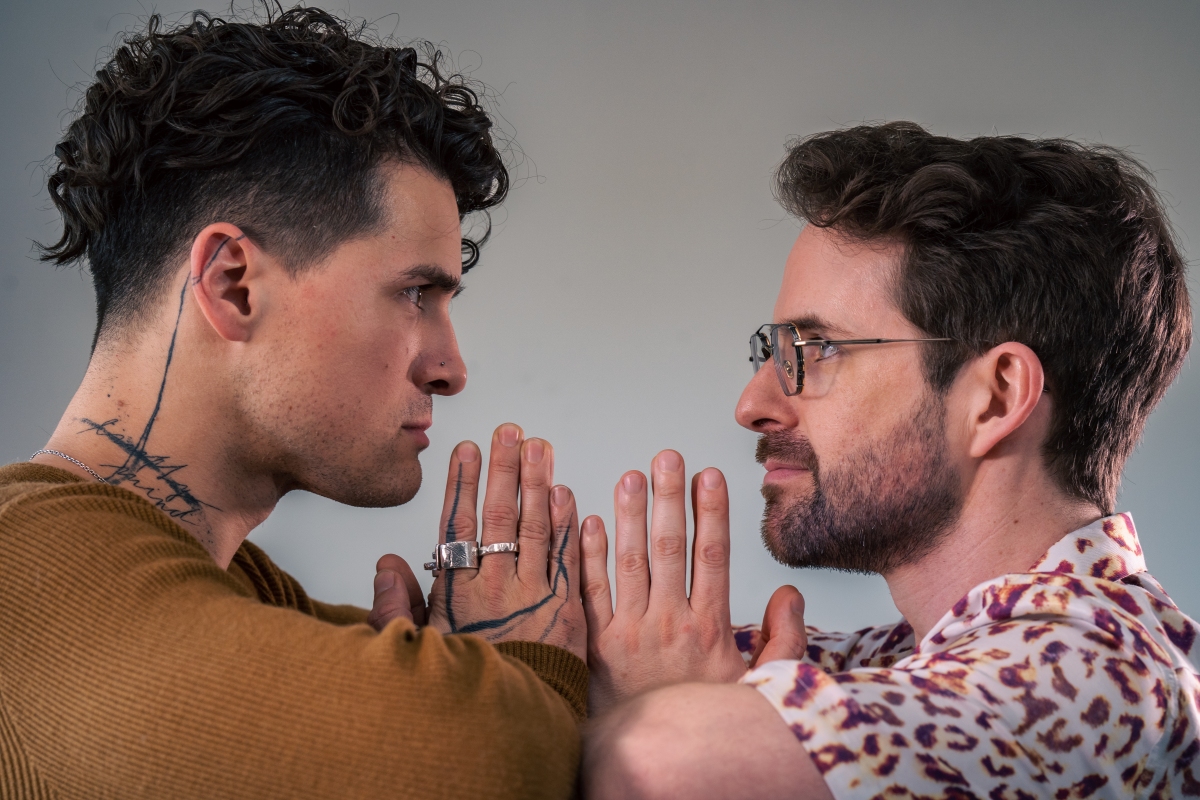
Anthony Padilla and Ian Hecox usher in the new era of Smosh
In their first YouTube video together in seven years, Ian Hecox and Anthony Padilla summoned a demon to score Taylor Swift tickets.
The sketch was gently absurd, infused with pop culture references, and above all, goofy as hell — all the markers of classic Smosh comedy.
“We were just approaching it from this place of excitement and passion, and like, ‘Let’s see how much we can make each other laugh,’” Padilla told TechCrunch in an interview at a VidCon. “It was the exact same feeling that I felt when we were creating stuff in those earliest days.”
Padilla spoke of Smosh’s early videos with an admiration few creators have for their past selves. While many might find their early writing unrefined or embarrassing, Padilla and Hecox lean into the unabashed playfulness that made Smosh so viral.
“I think that’s really at the core of that magic feeling of watching ourselves,” Padilla continued. “It doesn’t matter that it was silly or childish or cringy, because it made you laugh and it made you feel a real feeling.”
The sketch marks a new era for Smosh, a brand as old as YouTube itself. Hecox and Padilla acquired Smosh this month, more than a decade after they sold the company for the first time, and are setting the precedent for creators to own and define their contents’ legacy. While its former parent company Mythical Entertainment will maintain a minority stake in the brand, Smosh will be an independent entity for the first time in years. It’s a rare win for creators in the rapidly shifting social media landscape.
“If Anthony and I didn’t have control of this, some other company could just have rights to our content and use our images in whatever way they wanted to, and that to me is scary,” Hecox said. “I think through this whole process, I really understand and respect the idea of owning your art and owning your image.”
Hecox and Padilla, who were childhood friends, started posting videos together in 2005 and shaped YouTube’s early days with comedy sketches and vlogs. Smosh and its various spin-off channels were wildly popular, and the duo continued to churn out content after selling the brand to Defy Media in 2011. Smosh was the most-subscribed channel on YouTube three separate times from 2005 to 2013, and at its height, a powerhouse of content.
But the volume of output was unsustainable, and between launching apps, sitcoms, and constant sketches, Hecox and Padilla’s friendship — the foundation of Smosh’s brand — fell apart. Since they lived together at the time, there was no escape from work. The friends “operated out of fear,” Hecox said, and often skirted conflict to avoid jeopardizing their business partnership. Padilla said they were “spread thin” between the sheer amount of projects he was directing under pressure from Defy Media, which urged Smosh staff to post more content, most often, regardless of quality.
“I lost passion completely, and Ian and I had been growing apart, a bit because of the content, but also in huge part because we didn’t not know how to communicate, nor did we ever take the time to talk about our emotions or anything,” Padilla said. “Every discussion, every conversation that we had was about Smosh and about the company.”
“We had to let that friendship die,” Hecox added. “There wasn’t even much left.”
Padilla said he was discontent for years leading up to his 2017 departure from Smosh. The split shook viewers beyond just Smosh fans — after all, the brand’s entire identity revolved around Hecox and Padilla as best friends. Staffed by a team of writers and cast members, the brand continued to produce content without Padilla.
A year later, Defy Media folded, leaving Smosh “homeless.” Hecox said he was unsettled by the fact that so many of the other companies that bid on Smosh in the aftermath only wanted the brand for its content library. Rhett McLaughlin and Link Neal, known as the YouTubers Rhett and Link, ultimately acquired Smosh in early 2019.
Hecox said he trusted McLaughlin and Neal because, like Smosh, they built Mythical Entertainment as two friends creating content together. If Smosh had been acquired by any other company, he said, he doubts that the brand would be anything more than a content library today.
“If Rhett and Link weren’t the ones that had acquired Smosh after Defy collapsed, I don’t think I’d be around anymore,” Hecox said. “And one of the things that Rhett and Link were very adamant about was that if they acquired Smosh, they wanted assurance that I was going to stay, because they just get it. They understand that the value of having a channel is not in the subscribers, but it’s in the people that are a part of it.”
The fact that Smosh was acquired by other creators — not by a clueless corporation or ever-growing media conglomerate — allowed it to flourish for the first time in years. McLaughlin and Neal were relatively hands-off, Hecox said, which let the brand redefine its identity since they weren’t pressured into being a content mill.
In the years since leaving Smosh, Padilla rebranded himself as the modern talk show host. In his interview series “I spent a day with,” Padilla has spoken to furries, the faceless streamer Corpse Husband, survivors of school shootings, and others who found solace online because they don’t fit the social norm. His style of questioning — direct, empathetic, and gracious — has been praised by viewers as a rare example of discussing taboo topics without being voyeuristic.
Padilla said he’s been able to refine the more serious side of himself through his interview series, but he lacked the creative fulfillment that writing comedy provided. After seeing clips of old Smosh videos “popping off on TikTok” about a year ago, he went down a rabbit hole of rewatching himself and Hecox.
“Because I’ve been detached from it for so many years, I was able to approach it as kind of a new viewer, and found out there was a certain period of five years or so where I really felt this sense of magic that I became excited about,” Padilla said. “I just became a fan. I felt like watching other stuff on YouTube didn’t really satisfy me in a weird way.”
He and Hecox ended up reconnecting last year through mutual friends, and were able to hang out without making content for the first time since they were teenagers. Both creators credit their rekindled friendship to maturing and going to therapy. Padilla said that he learned to let go of the resentment that had festered in the years leading up to his departure. Shortly after they reconnected, Padilla began dreaming of reacquiring Smosh with Hecox, and drew up business plans months before Hecox floated the idea. He was “silent” about it, he said, because he never thought it could be a possibility.
Although the brand’s other channels, including Smosh Pit and Smosh Games, continued to thrive under Mythical Entertainment’s tutelage, Hecox said the main channel has been “struggling to find a voice.”
“Whenever we put out a sketch or some kind of specific type of video, it never resonated with the audience as a whole,” Hecox said of Padilla’s absence. “It was always very broad. For so many years it felt like we were fighting against the current.”
Hecox wanted to bring the channel back to its roots: sketch comedy. But that wouldn’t be possible, he said, without Padilla. He brought up buying back Smosh in December, and Padilla immediately launched into a detailed explanation of his plans.
But Hecox was “extremely skeptical” of their ability to write together after so many years. They set a date to test their chemistry, which Hecox doubted still existed.
“I wasn’t that enthusiastic about it,” Hecox laughed. “I was down to try it out, and very quickly, it felt like we fell right back into it. We were laughing a bunch and pitching crazy stuff, literally rolling on the floor.”
In their years apart, Hecox and Padilla have separately honed their writing skills. Their collaborative sessions have proven that they can play off each others’ strengths in a way they struggled to years ago, Hecox said.
“When we meet up, it feels like we’re firing on all cylinders.”
“When we meet up, it feels like we’re firing on all cylinders. Ian is kind of like the sun,” Padilla said. “Where he’s just casting all these ideas, and I feel like I’m a magnifying glass that focuses and moves to create that fire. That’s where the passion is. Focusing all of our energy and creating magic.”
Hecox said that when he approached McLaughlin and Neal about reacquiring Smosh, they were immediately on board. They “always wanted Anthony to come back,” he said, and were thrilled that the pair wanted to work together again.
“We acquired Smosh 4 years ago in the first creator-to-creator acquisition of its kind — a huge moment in Mythical’s history,” McLaughlin and Neal announced on Twitter. “We couldn’t think of a more outcome on our investment than selling Smosh back to the internet’s other iconic best-friend duo. It’s another pioneering first in the creator economy and a validation of our belief that creator-entrepreneurs will play a huge role in the future of entertainment.”
Aside from returning to their particular brand of sketch comedy, Hecox and Padilla envision a member-funded future for Smosh. They want their content to be “all killer, no filler” — both their desire to create and their rekindled friendship can only continue if they aren’t creatively fatigued. Their focus will be on producing “quality content” with limited output, and making bonus content for members behind a Patreon-style paywall. They didn’t have the tools to monetize sustainably when they first sold Smosh, Hecox said, but they’re planning to avoid making the same mistakes they did 10 years ago.
“With comedy, you can’t be expected to write multiple original sketches every single month. That’s insane,” Hecox said. “We want to look at this in a sustainable way. We’re not doing this sketch comedy for six months. We want to be doing this for 10, 15, 20 years.”
Though Mythical maintains a minority stake in the company, Hecox said McLaughlin and Neal will be more like their allies, but he and Padilla will have the reins.
Hecox and Padilla plan to handle their relationship differently, too.
“We’ll probably mention our feelings more than once every six years,” Hecox joked.
“For me, I really want to focus on communicating, and making sure that we are getting time to laugh with each other and talk about things that aren’t just strictly Smosh,” Padilla added. “Once things have fallen into place a little better. And hopefully take some vacations together that don’t revolve around work.”


